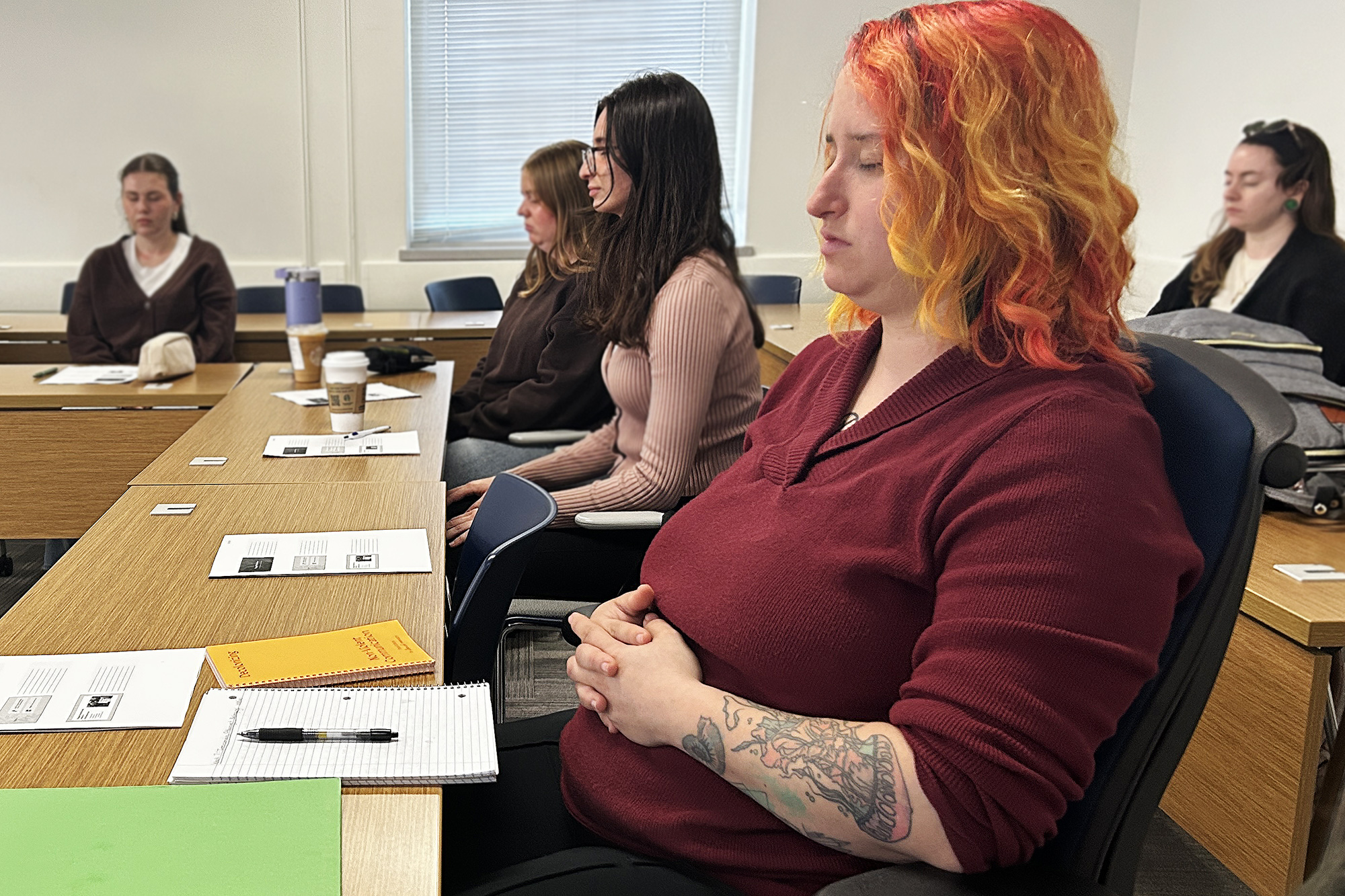
By Olivia Drake, Written Communications Specialist
At the University of Connecticut, Leena Alam ’25 is immersing herself in all-things material science and engineering (MSE).
Alongside her pursuit of pursing a degree in MSE, she’s the outreach chair for UConn’s materials science club Material Advantage; the treasurer for the Metal Working Club; an incoming teaching assistant for the MSE 2101 course; and a MSE social media contributor.
And now, through the opening of the new Science 1 building, she’s able to combine her academic and extracurricular interests under one roof while being enveloped by a community of like-minded materials science students and faculty. Science 1 is now home to the Institute of Materials Science (IMS) and the Materials Science and Engineering (MSE) Department.
On June 15, faculty, students, state representatives, and industry partners gathered at the new state-of-the-art research and teaching facility on King Hill Road for a ribbon-cutting ceremony, tours, and symposium.
Since the 1960s, IMS and the MSE Department occupied the north wing of the Edward V. Gant Science Complex. Even with multiple renovations, the building became ill equipped to house the needs of the growing programs. Research labs, undergraduate labs, faculty offices and classrooms were housed on different floors—and in some cases different buildings—which made for a hindered learning and teaching environment.
“Gant North was a wonderful facility for us for many reasons, but we were also bursting at the seams,” said MSE Department Head and Professor Bryan Huey.
“I personally love that we have an entire building dedicated to our field,” Alam said. “MSE is a huge up-and-coming field in terms of research and technology, and I’m glad we get a new space to fully explore all the projects we do here at UConn.”
THE SPECS

With an impressive 198,000 square feet of space spanning three stories, the new building includes 11 core user-facilities labs available to both campus users and regional industry partners, equipped with state-of-the-art instruments and equipment; the university’s 2,000-square-foot “clean room,” which offers a contaminate-free controlled environment for experiments; a 204-seat “active learning room” for campus-wide instructional use; office and administrative space; a machine shop; chemical and supply storeroom; meeting rooms for up to 50 attendees; and open spaces—called “neighborhoods”—that promote collaboration and social connections. The sun-lit lobby features a café, and overlooks a meandering landscaped pedestrian pathway designed to capture rainwater.
Crucially, four ground-floor teaching labs interconnected with a centralized teaching and project area are specifically for materials science and engineering undergraduates. The Materials Advantage, 3D Printing, and Metalworking clubs also gather in this space. Visible through a glass wall in the Science 1 lobby—”Science on Display!”—this integrated teaching facility promotes hands-on experience with instruments and processes that are critical in the materials industry centered around four themes: structure, processing, properties, and applications.
“Collectively, this is a profound improvement which will absolutely improve the quality of the undergraduate experience, dramatically improve materials education for our undergraduates and graduates, and make us even more of a destination for industry and other worldwide collaborators,” Huey said.
MATERIALS SCIENCE: FORGING AHEAD
It’s no secret that MSE programs—nationwide—generally have smaller undergraduate cohorts compared to other engineering disciplines. Here at UConn, less than 100 of the 3,576 engineering students chose to pursue a degree in materials science and engineering in 2022-23.
But this statistic has nothing to do with a lack of jobs.
“It’s simply a matter of prospective students—and more broadly the general public—not knowing enough about the importance of materials,” said Huey, who also serves as the current chair of the nationwide association of materials department heads University Materials Council. “Our students find plenty of internship opportunities, and our alumni do incredible things in aerospace, semiconductors, metallurgical, biomaterials , energy and the environment, product design, and so many other fields.”
Fortunately, in Connecticut, Huey explained, both political and institutional leadership are attuned to how crucial materials engineering is to the economic engine of the region—especially strength in advanced materials and manufacturing.
And this is why Science 1 was built, he said.

“Materials and their manufacture are critical for all of the technologies society relies upon every day, and which we need to keep improving to meet the technical and environmental needs for the future,” Huey explained. “We’re talking stronger, lighter, and more durable materials for space exploration, air travel, and self-driving vehicles; implantable materials for biomedical applications and even regenerative engineering; more cost-effective materials manufacturing, including resource recovery and recycling; down-to-atomic-scale control in semiconductor fabrication for ever-more demanding computing needs; improved energy sources like hydrogen fuel cells and next generation solar cells; and so many other examples.”
Furthermore, everything “that is amazing in a modern mobile phone”—screen, battery, antenna, computing power, embedded sensors, camera, and more—relies on advances by material engineers, Huey said.
Science 1 is one of the largest projects in Next Generation Connecticut (NextGenCT), a state initiative that aims to expand educational opportunities, research, and innovation in the science, technology, engineering, and math (STEM) disciplines at UConn while helping to build Connecticut’s future workforce, create jobs, and invigorate the state’s economy.
“Science 1 is transforming the way we educate,” UConn President Radenka Maric said at the ribbon-cutting ceremony. “We want to be at the top of innovation in Connecticut. I always tell people Connecticut is a state of innovation, we are just too humble to tell people how innovative we are.”
KEEPING CONNECTIONS
Although the majority of MSE’s academic efforts will take place in Science 1, the department will continue to network with UConn’s Innovation Partnership Building (IPB) and the Center for Clean Energy Engineering (C2E2).
Equally, IMS and the MSE Department will continue to welcome researchers from more than 100 groups campus-wide—including faculty from UConn Avery Point and UConn Health—to use the advanced facilities and ample collaboration space in Science 1.

IMS not only supports students specializing in materials science and engineering, polymer science, and materials science, but several other programs needing to conduct materials-related research as well. The Institute oversees the Industrial Affiliates Program, an industry outreach initiative designed to assist Connecticut-based companies in enhancing their research and development endeavors; the Electrical Insulation Research Center; and the Center for Advanced Microscopy and Materials Analysis (CAMMA) Laboratory as well as the X-ray facility located in the Innovation Partnership Building (IPB).
“The interdisciplinary and multi-purpose use of the IMS Science 1 facility allows collaboration among researchers from many schools and colleges at UCONN including the School of Engineering; the College of Liberal Arts and Sciences; College of Agriculture, Health and Natural Resources; UConn Health; and others,” said Steven Suib, IMS director and UConn Board of Trustees Distinguished Professor in chemistry. “The opportunity to have different researchers from different areas to have offices and labs together is a unique feature which promotes research collaborations of all members of IMS, MSE, and other units.”
NEEDED: SPACE FOR RESEARCH AND COLLABORATION
Materials is a lab-heavy discipline, Huey explained. “Some of us need vibrationally stable ground floor space, others need high-bay facilities, some have extensive power and air handling requirements, and others need fume hoods and wet-labs. In Gant, we had all of that functioning at a basic level. Science 1 maintains—and indeed enhances—such purpose-built functionality. But it is also designed with a much more modern philosophy and aesthetic that is really centered on encouraging collaboration.”

Alam, who is “super interested in renewable/alternative energy and biodegradable plastics” is working as an undergraduate researcher for MSE Professor Rainer Hebert’s Thermal Expansion Lab. The lab, formerly housed in Gant, reopened in Science 1 in January, prior to the formal building dedication this June.
“The lack of space in our labs [in Gant North] generally made it harder to move around, so I’m super glad there’s enough space for all the equipment we do research with,” Alam said. “I also appreciate the design of the new building and how it supports collaboration and teamwork in research.”
MSE major Steiny Duong ’24 is an undergraduate researcher in the Material Dynamics and Electron Microscopy Lab in Science 1 where he works with MSE Professor Mark Aindow on materials characterization utilizing various techniques with an emphasis on electron microscopy.
“I think the MSE labs in Science 1 are indeed a vast improvement over the old labs in that they provide much more space for studying and learning,” he said. “Also the rooms are more accessible in that they are close to each other and contain all the required equipment and instruments for lab work. I think in this way it presents a much more student and professor friendly atmosphere.”
Like Alam and Duong, Audrey Larson ’25, who is double majoring in MSE and civil engineering, will use the laboratories in Science 1 for research. She’s already worked with Douglas Adamson, professor of chemistry, in his Polymer Composite Lab in Science 1.
Science 1, Larson says, represents the next generation of innovation and creativity at UConn.
“The Science 1 building is designed for collaboration, and I can’t wait to utilize the space for networking, brainstorming, and group work. The collaborative classroom space and study spaces lend themselves to pushing students closer together,” she said. “It also houses labs that have the capability to change materials science and advanced manufacturing as we know it.”
THE EVOLUTION OF MATERIALS SCIENCE
Engineering at UConn dates back more than 140 years as a program within the newly established Storrs Agricultural School. In the 1880s, courses were available in surveying, mechanical drawing, physics, chemistry, and mathematics. In 1901, the school began offering a two-year program in mechanic arts.
At the time, classes were held in the basement of (the now razed) Whitney Hall, UConn’s first building named in honor of Edwin Whitney. By 1920, classes moved from the basement of (now razed) to the Mechanic Arts Building on North Eagleville Road (currently UConn’s Islamic Center).

By 1916, the renamed Connecticut Agricultural College offered a four-year, Bachelor of Science degree in mechanical engineering; Earl R. Moore was the first graduate in 1920.
In 1939, the institution was again renamed—from Connecticut State College—to the University of Connecticut. That same year, the Engineering I building (later named the Francis L. Castleman Jr. Building after the late dean) was completed, and by 1950, more than 230 students graduated from UConn with a degree in engineering.
Initially, the Mechanical Engineering Department and the Chemical Engineering Department offered formal instruction in metallurgy. But in 1967, UConn began offering graduate degrees in the newly-named Metallurgy Department.
“LinkedIn data suggests that more than 1,600 UConn alumni graduated with degrees in metallurgy or materials science since 1969,” Huey said.
According to Owen Devereux, a former professor of metallurgy, the Metallurgy Department attracted several new faculty in the early 1990s who brought with them new areas of research, notably ceramics, compositive materials, and solid free-form fabrication. This encouraged the development of viable classroom programs in these areas and a department name change: The Department of Metallurgy and Materials Engineering.
In the early 2000s, the Metallurgy and Materials Engineering Department was renamed the Materials Science and Engineering Department to reflect the broadening role of polymers, composites and other materials in industry and medicine. UConn simultaneously unveiled a curriculum for a Bachelor of Science in Materials Science and Engineering—the only undergraduate materials science and engineering degree program offered by a public university in New England.

The BS in MSE will celebrate its 20th anniversary in 2024.
Students joining this degree program are exposed to an applied and tailorable curriculum. Like most engineers, they take General Chemistry, Differential Equations, Calculus I and II, Physics for Engineering I and II, Programming, Applied Mechanics, Intro to Engineering, and Intro to Materials I and II. More focused materials courses include Thermodynamics and Phase Transformations, Mechanical Behavior, Transport Phenomena, Electronic and Magnetic Properties, Materials Characterization, and a one-year, industry-sponsored Capstone Design team project. Students then choose five materials elective classes, three other STEM-related classes, and general education and free electives.
“And most important of all: MSE students are fortunate to take lots of memorable hands-on labs. In fact, the MSE bachelor’s degree program includes more lab sections than any other engineering major, and this is consistently one of the favorite aspects of our major for our students and especially our alumni,” Huey said. “Our students are so well prepared to jump right into internships, jobs, grad school and apply what they’ve learned.”
Courses are taught by 18 core faculty and 16 affiliated faculty, scholars, and advisors. Maric is among the core faculty and is an expert in novel materials for high temperature fuel cells.
Larson is excited to begin the fall semester in the new space.
“By placing the Materials Science and Engineering Department in Science 1, UConn is showing its commitment to the field and further emphasizing how important materials research will be to the future of UConn, Connecticut and the whole world,” she said. “The Science 1 building represents a new level of commitment to Materials Science and Engineering that is so exciting to witness. I cannot wait to be part of the first group of students, researchers and faculty who get to walk the halls.”



